Easily convert between grams, cups, ounces and millilitres for many popular baking ingredients including flour, sugar, butter and many more.
The Calculator
NOTE - A tablespoon in these conversions is 15ml (the standard size in the UK/US). A cup is assumed to be 240ml.
For more information about how to use this calculator and how the conversions have been derived, please have a read of everything below...
- About this calculator
- How to fill a cup for baking?
- Are you best using scales or cups for baking? - it's scales and I've got a big list to explain why
- What is a scant cup?
- How are the measurements in the calculator rounded?
- Conversion tables
Select Ingredient
- Water
- Sugar - Caster, Granulated, Icing, Powdered, Confectioners, Brown
- Flour - Plain, All-purpose, Self-raising, Spelt, Wholemeal
- Fats & Oils - Butter, Margarine, Vegetable oil
- Milk & Cream
- Cocoa Powder
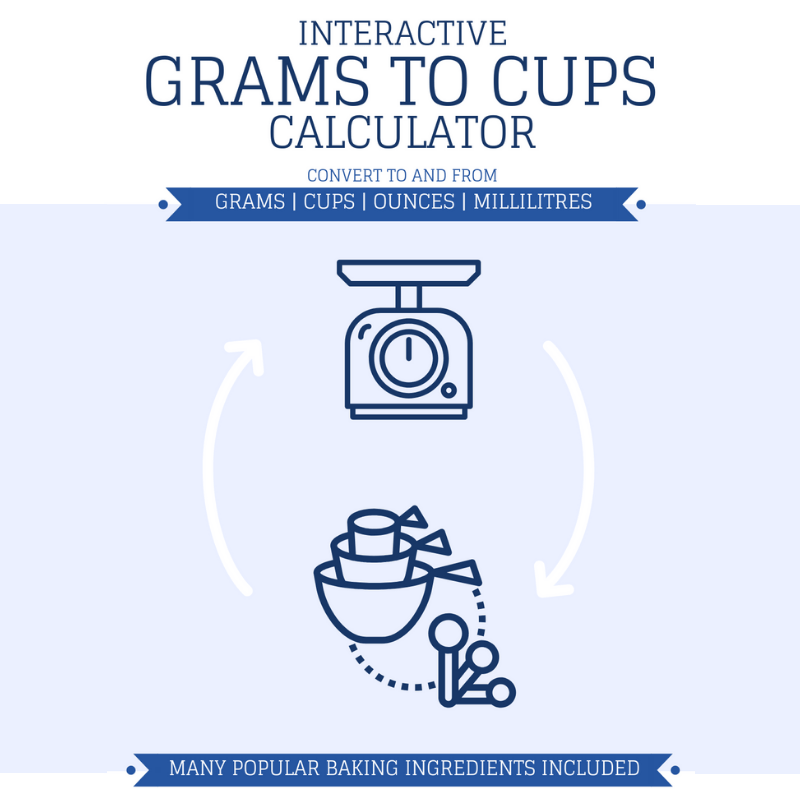
About this calculator
Isn't it annoying when you find a recipe in US cups, and you only have scales or vice versa?
Well, I now have the solution... my Interactive Grams to Cups / Cups to Grams Calculator.
I've called it "grams to cups / cups to grams" as they're the conversions I get asked for most often, but actually, it can convert between grams, cups, ounces or millilitres for many common baking ingredients. So you can go from grams to cups, or cups to grams, from cups to millilitres or grams to ounces to your heart's content.
Simply select your ingredient, what you'd like to convert from and to and enter the amount, and it'll tell you exactly what you need.
The ingredients currently included in the calculator are:
- Water
- Sugars & Sweeteners - Caster Sugar, Granulated Sugar, Icing/Powdered Sugar, Brown Sugar, Maple Syrup, Runny Honey, Golden Syrup and Black Treacle
- Flours - Self-Raising Flour, Plain Flour, Spelt Flour, Wholemeal Flour and Cornflour
- Fats & Oils - Butter, Margarine and Vegetable Oil
- Nuts & Seeds - Ground Almonds, Chia Seeds and Linseeds/Flax Seeds
- Milk & Cream - Milk, Single Cream, Double Cream, Half-and-half, Whipping Cream, Heavy Cream, Buttermilk
- Other Ingredients - Cocoa Powder, Chocolate Chips, Mini Marshmallows, Popping Corn, Raisins, Cream Cheese, Desiccated Coconut, Pudding Rice, Nutella, Custard and Skimmed Milk Powder
I'll be adding new ingredients all the time. If there's one missing that you'd love to see here then do let me know in the comments.
FREE GRAMS TO CUPS CONVERSION CHARTS
Subscribe to the Charlotte’s Lively Kitchen mailing list to get your FREE printable grams to cups and cups to grams conversion charts for twelve popular baking ingredients
How to fill a cup for baking
I asked my followers on social media about how they fill cups. The majority scoop ingredients such as flour or sugar out of the bag and then level the top, so that's the approach I've taken when measuring similar ingredients for my calculator. I also like to give the bag a little squeeze beforehand to break up any lumps.
Many conversion charts give 1 cup of flour as 120g. However, I've found the only way I can get it that low is to sift the flour and then use a spoon to fill the cup with the sifted flour. I don't know about you, but I prefer to sift flour after it's been measured, not before. So in my conversions, you'll find a cup of flour weighs more as it reflects how I fill a cup.
For ingredients in smaller packets, I pour them into the cup straight from the bag and level the top.
For soft ingredients such as butter or cream cheese, I push them into the cup with the back of a spoon to ensure any gaps are filled and then level the top.
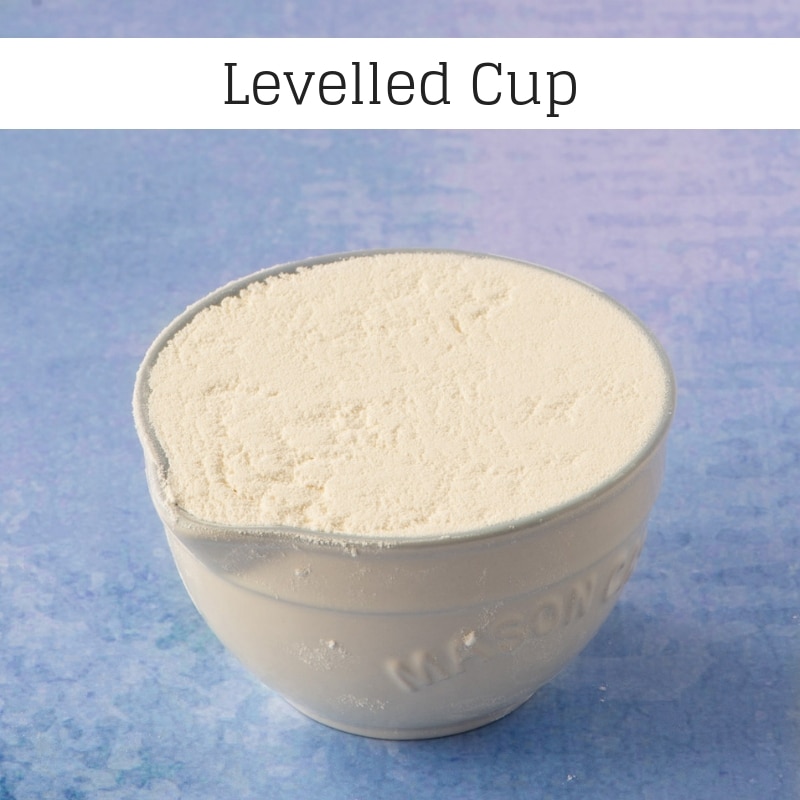
Are you best using scales or cups for baking?
In baking accuracy is important, so for my baking recipes I recommend always using grams if you can.
There are several reasons I'd recommend using weighed ingredients rather than cups:
The conversion varies depending on how you fill your cup
When I was working out all of the conversions for this calculator, I found that how I filled a cup could significantly impact the amount of an ingredient I could fit in.
In the image below both cups appear to be full of flour. However, the one on the right weighs over 40% more than the one on the left, as I packed the flour in as tightly as possible.
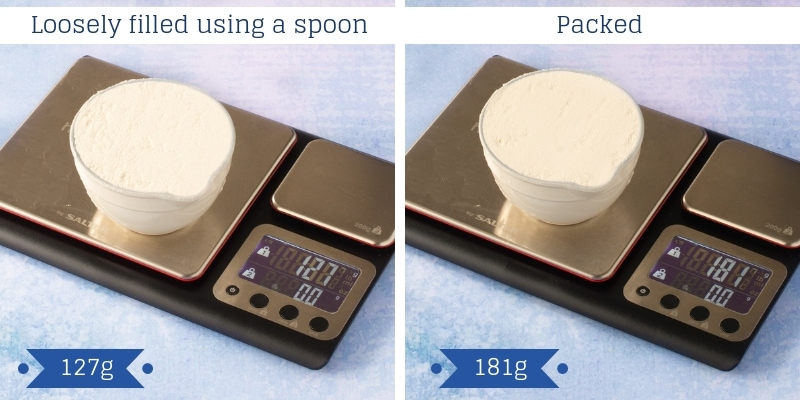
A cup isn't always a cup
The official size of a US cup is 236.588ml, but most cups available to buy in the shops assume it to be 240ml for simplicity (this is what I've assumed in my calculator). However, there are some cup manufacturers sell cups that are 250ml (but keep a ½ cup at 120ml!).
This isn't a huge problem as long as you know which you own. A bigger problem is that not all cups sold are hugely accurate.
I own two sets of measuring cups, and neither holds the amount they're supposed to. In one set my ¼ cup holds 65ml (it should be 60ml), yet the full cup only holds 225ml when it should be 240ml (don't worry I've adjusted everything here to ensure it's accurate for a correctly-sized cup).
Some ingredients can be tricky to get into the cup
If you've got a recipe such as scones or shortcrust pastry that need cold butter straight from the fridge, how do you get it into the cup to measure it?
Not everything fits nicely in a cup
Imagine measuring walnuts. If you put them into a cup whole, you're going to fit in a lot less than if you finely chop them before adding them to the cup.
You got the ingredient into the cup, but how do you get it back out again?
There are also some ingredients such as Nutella or Black Treacle that are tricky to remove from the cup after filling. It's unlikely that you'll get everything out that you put in so you may well end up adding less to your mixture than the recipe calls for.
Do you really want to be washing up mid-baking?
Many sets of scales have a tare button which allows you to rest the scales to 0 so you can keep measuring more ingredients into one bowl. The is great as it means you can pour in everything you need for your mixture without getting lots of extra measuring utensils dirty.
Imagine you've got a recipe that calls for a cup of butter, flour, maple syrup and Nutella (not too sure what you'd be making!). To get an accurate measurement, you'll need to either own lots of cups or wash the cup up between each ingredient before you can measure the next one.
What is a scant cup?
A scant cup is just under a cup. As measurements go it's a bit vague! Similarly, the amount you can fit into a heaped cup can vary significantly depending on the shape of the cup. I therefore don't use either of these descriptions in my recipes (it's a flat cup, tablespoon or teaspoon for me).
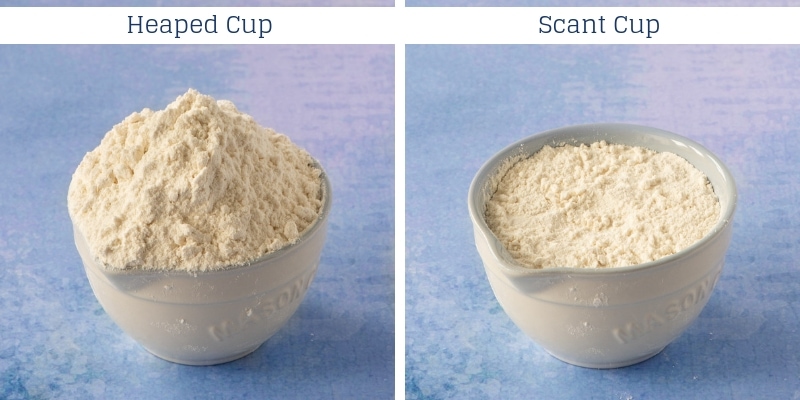
How are the measurements in the calculator rounded?
To keep the conversions to amounts that can be easily measured in the kitchen I've rounded...
- Grams to the nearest gram
- Millilitres to the nearest millilitre
- Ounces to the nearest ¼ ounce
- Cups to the nearest
- ¼ teaspoon (for under 1 teaspoon)
- Teaspoon for under ¼ cup
- Tablespoon for over ¼ cup
Conversion tables
In addition to the main calculator, I thought it would be helpful to provide conversion tables for a selection of the most popular ingredients.
Water
| WATER - GRAMS TO CUPS | |
|---|---|
| Grams | Cups |
| 50g | 3 tbsp + 1 tsp |
| 100g | ¼ cup + 3 tbsp |
| 200g | ¾ cup + 1 tbsp |
| 250g | 1 cup + 1 tbsp |
| 300g | 1¼ cups |
| 400g | 1½ cups + 3 tbsp |
| 500g | 2 cups + 1 tbsp |
| WATER - CUPS TO GRAMS | |
|---|---|
| Cups | Grams |
| 1 tsp | 5g |
| 1 tbsp | 15g |
| ¼ cup | 60g |
| ⅓ cup | 80g |
| ½ cup | 120g |
| 1 cup | 240g |
Sugar
Caster sugar
| CASTER SUGAR - GRAMS TO CUPS | |
|---|---|
| Grams | Cups |
| 50g | ¼ cup |
| 100g | ½ cup |
| 200g | 1 cup |
| 250g | 1¼ cups |
| 300g | 1½ cups |
| 400g | 2 cups |
| 500g | 2½ cups |
| CASTER SUGAR - CUPS TO GRAMS | |
|---|---|
| Cups | Grams |
| 1 tsp | 4g |
| 1 tbsp | 13g |
| ¼ cup | 51g |
| ⅓ cup | 67g |
| ½ cup | 101g |
| 1 cup | 202g |
Granulated Sugar
| GRANUALTED SUGAR - GRAMS TO CUPS | |
|---|---|
| Grams | Cups |
| 50g | 3 tbsp + 2 tsp |
| 100g | ¼ cup + 3 tbsp |
| 200g | ¾ cup + 3 tbsp |
| 250g | 1 cup + 3 tbsp |
| 300g | 1½ cups + 2 tbsp |
| 400g | 1¾ cups + 2 tbsp |
| 500g | 2¼ cups + 1 tbsp |
| GRANULATED SUGAR - CUPS TO GRAMS | |
|---|---|
| Cups | Grams |
| 1 tsp | 4g |
| 1 tbsp | 13g |
| ¼ cup | 54g |
| ⅓ cup | 72g |
| ½ cup | 108g |
| 1 cup | 215g |
Icing / powdered / confectioners sugar
| ICING / POWDERED/ CONFECTIONERS SUGAR - GRAMS TO CUPS | |
|---|---|
| Grams | Cups |
| 50g | ¼ cup + 1 tbsp |
| 100g | ½ cup + 3 tbsp |
| 200g | 1¼ cups + 2 tbsp |
| 250g | 1½ cups + 3 tbsp |
| 300g | 2 cups + 1 tbsp |
| 400g | 2¾ cups |
| 500g | 3¼ cups + 3 tbsp |
| ICING / POWDERED / CONFECTIONERS SUGAR - CUPS TO GRAMS | |
|---|---|
| Cups | Grams |
| 1 tsp | 3g |
| 1 tbsp | 9g |
| ¼ cup | 37g |
| ⅓ cup | 49g |
| ½ cup | 73g |
| 1 cup | 146g |
Brown sugar (packed)
| BROWN SUGAR (PACKED) - GRAMS TO CUPS | |
|---|---|
| Grams | Cups |
| 50g | ¼ cup |
| 100g | ½ cup |
| 200g | 1 cup |
| 250g | 1¼ cups |
| 300g | 1½ cups |
| 400g | 2 cups |
| 500g | 2¼ cups + 3 tbsp |
| BROWN SUGAR (PACKED) - CUPS TO GRAMS | |
|---|---|
| Cups | Grams |
| 1 tsp | 4g |
| 1 tbsp | 13g |
| ¼ cup | 51g |
| ⅓ cup | 68g |
| ½ cup | 102g |
| 1 cup | 203g |
Flour
White flour - plain, all-purpose, self-raising, spelt
| WHITE FLOUR - GRAMS TO CUPS | |
|---|---|
| Grams | Cups |
| 50g | ¼ cup + 1 tbsp |
| 100g | ½ cup + 2 tbsp |
| 200g | 1¼ cups |
| 250g | 1½ cups + 1 tbsp |
| 300g | 1¾ cups + 2 tbsp |
| 400g | 2½ cups |
| 500g | 3 cups + 2 tbsp |
| WHITE FLOUR - CUPS TO GRAMS | |
|---|---|
| Cups | Grams |
| 1 tsp | 3g |
| 1 tbsp | 10g |
| ¼ cup | 40g |
| ⅓ cup | 54g |
| ½ cup | 81g |
| 1 cup | 161g |
Wholemeal / brown flour
| BROWN FLOUR - GRAMS TO CUPS | |
|---|---|
| Grams | Cups |
| 50g | ¼ cup + 1 tbsp |
| 100g | ½ cup + 2 tbsp |
| 200g | 1¼ cup + 1 tbsp |
| 250g | 1½ cup + 2 tbsp |
| 300g | 1¾ cups + 3 tbsp |
| 400g | 2½ cups + 1 tbsp |
| 500g | 3¼ cups |
| BROWN FLOUR - CUPS TO GRAMS | |
|---|---|
| Cups | Grams |
| 1 tsp | 3g |
| 1 tbsp | 10g |
| ¼ cup | 39g |
| ⅓ cup | 52g |
| ½ cup | 78g |
| 1 cup | 155g |
Cornflour (UK) / cornstarch (US)
| CORNFLOUR / CORNSTARCH - GRAMS TO CUPS | |
|---|---|
| Grams | Cups |
| 50g | ¼ cup + 3 tbsp |
| 100g | ¾ cup + 1 tbsp |
| 200g | 1½ cups + 2 tbsp |
| 250g | 2 cups + 1 tbsp |
| 300g | 2¼ cups + 3 tbsp |
| 400g | 3¼ cups |
| 500g | 4 cups + 2 tbsp |
| CORNFLOUR / CORNSTARCH - CUPS TO GRAMS | |
|---|---|
| Cups | Grams |
| 1 tsp | 3g |
| 1 tbsp | 8g |
| ¼ cup | 31g |
| ⅓ cup | 41g |
| ½ cup | 61g |
| 1 cup | 122g |
Fats and oils
Butter / margarine
| BUTTER / MARGARINE - GRAMS TO CUPS | |
|---|---|
| Grams | Cups |
| 50g | 3 tbsp + 2 tsp |
| 100g | ¼ cup + 3 tbsp |
| 200g | ¾ cup + 2 tbsp |
| 250g | 1 cup + 2 tbsp |
| 300g | 1¼ cups + 2 tbsp |
| 400g | 1¾ cups + 1 tbsp |
| 500g | 2¼ cups |
| BUTTER / MARGARINE - CUPS TO GRAMS | |
|---|---|
| Cups | Grams |
| 1 tsp | 5g |
| 1 tbsp | 14g |
| ¼ cup | 56g |
| ⅓ cup | 74g |
| ½ cup | 111g |
| 1 cup | 222g |
How much does a stick of butter weigh?
I've seen many recipes from the US calling for a stick of butter, but just how much butter do you actually get in a stick?
A stick of butter = 113g = 4oz = ½ cup
Vegetable oil
| OIL - GRAMS TO CUPS | |
|---|---|
| Grams | Cups |
| 50g | 3 tbsp + 2 tsp |
| 100g | ¼ cup + 3 tbsp |
| 200g | ¾ cup + 3 tbsp |
| 250g | 1 cup + 3 tbsp |
| 300g | 1¼ cups + 2 tbsp |
| 400g | 1¾ cups + 2 tbsp |
| 500g | 2¼ cups + 1 tbsp |
| OIL - CUPS TO GRAMS | |
|---|---|
| Cups | Grams |
| 1 tsp | 4g |
| 1 tbsp | 13g |
| ¼ cup | 54g |
| ⅓ cup | 71g |
| ½ cup | 107g |
| 1 cup | 214g |
Milk / Cream
| MILK / CREAM - GRAMS TO CUPS | |
|---|---|
| Grams | Cups |
| 50g | 3 tbsp |
| 100g | ¼ cup + 2 tbsp |
| 200g | ¾ cup + 1 tbsp |
| 250g | 1 cup |
| 300g | 1 cup + 3 tbsp |
| 400g | 1½ cups + 1 tbsp |
| 500g | 1¾ cups + 3 tbsp |
| MILK / CREAM - CUPS TO GRAMS | |
|---|---|
| Cups | Grams |
| 1 tsp | 5g |
| 1 tbsp | 16g |
| ¼ cup | 64g |
| ⅓ cup | 85g |
| ½ cup | 128g |
| 1 cup | 255g |
Cocoa Powder
| COCOA POWDER - GRAMS TO CUPS | |
|---|---|
| Grams | Cups |
| 50g | ¼ cup + 3 tbsp |
| 100g | ¾ cup + 2 tbsp |
| 200g | 1¾ cups + 1 tbsp |
| 250g | 2¼ cups |
| 300g | 2½ cups + 3 tbsp |
| 400g | 3½ cups + 2 tbsp |
| 500g | 4½ cups |
| COCOA POWDER - CUPS TO GRAMS | |
|---|---|
| Cups | Grams |
| 1 tsp | 2g |
| 1 tbsp | 7g |
| ¼ cup | 28g |
| ⅓ cup | 37g |
| ½ cup | 56g |
| 1 cup | 111g |
Pin This Calculator
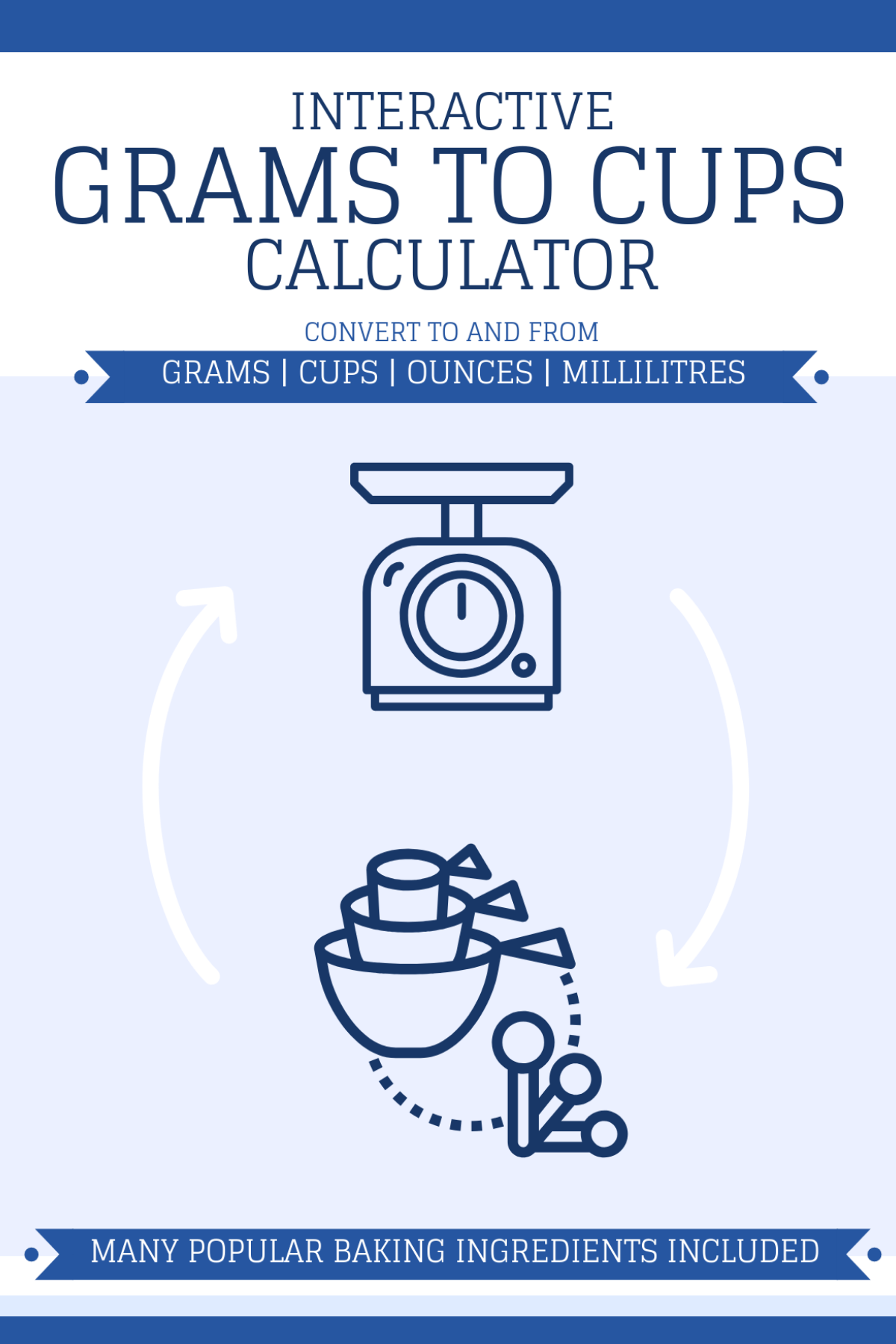



gloria says
Your page is a life saver for this American girl! Ha Ha. I looked all over the internet and finally found a straight answer with a calculator to help me. thank you so much, I tabbed your page because I’m pretty sure I will be coming back again and again.
Steven says
Where would bread flour or “00” flour be measure with?
Charlotte Oates says
The plain/all-purpose flour conversion works for 00 flour.
Jenny says
Thank you for this resource!
Avinash says
Could you please add peanut butter to the list?
Otherwise, thanks for all the work you put into this.
Thanks,
Avinash
Maree says
Hi! Can you add oats please? 🙂
Charlotte Oates says
On the list!
Mike Phoenix says
This is tremendously helpful!
Many recipes in the US require “sweetened condensed milk” which is sold in cans… would it be possible to add conversions for that product?
Charlotte Oates says
I will make a note!
Abiola says
Please under what do beans flour belong?
Charlotte Oates says
Each bean flour will likely have a different density and therefore a different weight to volume ratio.
Michelle says
Thank you so much, this is really helpful
Carol says
Does almond flour fall under wholemeal flour?
Charlotte Oates says
Unfortunately I have not tested the almond flour conversion as yet.
Tracy says
Hi Charlotte! As a European food blogger, this is so helpful! I especially love the fact that you can put in your grams and it is magically converted to cups, tbsp and tsp! Fantastic.
Could you please add Greek yoghurt? 🙂
Nana Titus says
Thanks this is really helpful. Can you add yeast too.
Charlotte Oates says
noted!
RP says
Your AP flour 161 grams/cup is significantly different from others: cf LATimes “What does a cup of flour weigh”
King Arthur Flour: 120 grams
Bake From Scratch: 125 grams
Washington Post: 126 grams
The New York Times: 128 grams
Bon Appétit: 130 grams
AllRecipes.com: 136 grams
The L.A. Times; Cook’s Illustrated: 142 grams
Charlotte Oates says
As you have shown from your research the number of grams in a cup can vary significantly depending on who is going the measuring.
I have outlined in my post how I have chosen to measure the flour so every is clear on the method I’ve used. I’ve also demonstrated the huge variation that can occur in flour measurements according to how tightly or loosely packed it is. Unfortunately due to the nature of flour the method is important.
Stacey says
I noticed that too, but went back and read how you measured it. I have a recipe from YouTube and the baker, scooped the flour out of the bag, weighed out 800 grams, then sifted. I checked some of those sites, like King Arthur and they don’t say if they sifted it first or not. I’m going with yours to convert. That makes more sense and that’s how I do it. I don’t want to buy another thing, scale, for my kitchen. Have enough stuff I don’t use very often.
Ellen says
Can you add salt please?
Thank you.
Lost between the UK & USA
Ellen says
And yeast too please!
Thank you.
Lost between the UK & USA
Cynthia says
Thanks very educative
Judith says
Thank you so much
kate says
thanks alot
Neena says
Thanks. Can you add sunflower seeds too
Chisom says
Thanks alot.
This is really helpful